Measuring Arterial Oxygen Saturation During Exercise in People with COPDUsing Finger and Forehead SensorsPresented by: Stephanie Wilson, School of PhysiotherapyCourse: Bachelor of <strong>Science</strong> (Physiotherapy) (Honours)Supervisors: A/Prof. Sue Jenkins, Dr. Kylie Hill, Michelle Melang, Nola CecinsBackground: During exercise training and testing, arterial oxygen saturation is commonlymeasured by pulse oximetry via a finger sensor (SpO 2 ). However, finger sensors have beenassociated with erroneous readings. We sought to determine whether an alternative sensor (i.e.positioned on the forehead) provides more accurate measures of SpO 2 compared with a fingersensor in people with chronic obstructive pulmonary disease (COPD) who were known todesaturate during lower limb exercise.Methods: During a standard lower limb exercise task, SpO 2 was measured continuously by twopulse oximeters; one attached via a finger sensor and one attached via a forehead sensor.Arterialised capillary samples were collected as a gold standard measure of arterial oxygensaturation, prior to the start (rest) and at completion of exercise test (end-exercise).Results: 13 participants completed the study (forced expiratory volume in one second = 0.77 [0.27]L; 6 males). Compared with measures obtained in arterialised capillary blood, on average, thefinger sensor under-read SpO 2 by 2% (limit of agreement 3%) and the forehead sensor over-readSpO 2 by 2% (limit of agreement 3%). <strong>The</strong> magnitude of change in arterial oxygen saturationbetween rest and end-exercise was similar between the finger, forehead and arterialised capillarysamples, being -6%, -7% and -7%, respectively (p = 0.48).Conclusion: Arterialised capillary samples comprise a mixture of arterial and venous blood andtherefore the oxygen saturation in these samples is slightly less than that of arterial blood. As thearterial oxygen saturation measured using the forehead sensor was slightly higher than thatmeasured in the arterialised capillary sample, it is likely that this sensor produced measures thatwere more concordant with arterial oxygen levels. Both sensors were accurate in detecting themagnitude of exercise-induced desaturation.Investigating the Role of Tumour Associated Macrophages in MesotheliomaPresented by: Teong Ling Yeoh, School of Biomedical <strong>Science</strong>sCourse:Bachelor of <strong>Science</strong> (Medical <strong>Science</strong>) (Honours)Supervisors: Dr. Delia Nelson, Dr. Connie JackamanMalignant Mesothelioma (MM) is a cancer usually located in the pleural cavity and is caused byinhalation of asbestos fibres. <strong>The</strong> median survival of MM patients post diagnosis is 12 months, andcurrent treatment options extend survival by a few months. <strong>The</strong>re is increasing evidence that theanti-tumour immune response is impaired in MM patients. Multiple mechanisms of immunesuppression may be involved to ensure immune sabotage.One possible mechanism is mediated via specific macrophage subsets. Classically activatedmacrophages are classified as M1 cells and alternatively activated macrophages are M2 cells. M1cells are proinflammatory cells and M2 cells are generally anti-inflammatory cells. A furthermacrophage-like subset is referred to as Myeloid Derived Suppressor Cells (MDSCs) which areimmature cells of myeloid origin. MDSCs have been shown to suppress immune responses. M2cells and MDSC cells are associated with progressing tumour growth. <strong>The</strong>se macrophage subsetsare plastic and can be polarized from one subset to another by appropriate stimuli.This honours project aims to characterise macrophage subsets in progressing murine MM tumours,and to assess if they can be therapeutically modulated. Preliminary in vitro studies co-culturingsupernatant generated from murine MM tumour cells with murine macrophages suggest that thetumour environment may promote an M2-like phenotype. In vivo analysis was subsequentlyperformed on tumours, bone marrow and spleen collected at various stages of MM tumour growth.Immunohistochemistry and flow cytometry showed that tumour-infiltrating macrophages were seenin very high numbers at the early stages of tumour growth and significantly increased duringtumour growth. MDSCs were also significantly increased within the tumour, spleen and bonemarrow during tumour progression. This project will next investigate whether polarisingmacrophages to immunogenic subsets will inhibit MM growth in vivo. <strong>The</strong>se results may provideinsights into new potential therapeutic targets for MM.
Paper PresentersOsteoarthritis of the Knee Self-Management Education Program Delivered byMultidisciplinary <strong>Health</strong> Professionals; a Randomised Controlled TrialPresented by: Sophie Coleman, School of PhysiotherapyCourse: Doctor of PhilosophySupervisors: A/Prof. Kathy Briffa, Prof. Joan ColePurpose: To determine whether a disease specific self-management program (OAK) for peoplewith osteoarthritis (OA) of the knee, implemented by multidisciplinary health professionals in aprimary health care setting, could achieve and maintain clinically meaningful improvementscompared to a control group.Relevance: Self-management is thought to be an effective strategy in the treatment of chronicillness like OA although there is no robust evidence to support it. OAK is a disease specific OA selfmanagementeducation program designed for delivery by multidisciplinary health professionals toenhance participant’s self-efficacy and promote long-term changes in behaviour. Within theconstructs of self-management, exercise and disease coping strategies are promoted as a meansto improve quality of life, general health and pain.Description: Participants: Medical practitioners referred 146 participants (37 male and 109 female)with established OA knee, mean age of 65 years. Volunteers were excluded for coexistentinflammatory joint disease or serious co-morbidities.Interventions: Participants were randomised into either control or OAK groups (ratio 1:1). <strong>The</strong> OAKgroup completed the six-week self-management education program. <strong>The</strong> control group had a sixmonthwaiting period before receiving the OAK program.Measurements: All participants were assessed at baseline, eight-weeks and six-months. Primaryoutcomes: VAS pain, WOMAC and SF-36 questionnaires were completed. Secondary outcomeswere: a modified “timed get up and go” test, quadriceps and hamstring strength- isometriccontraction assessed using a dynamometer, and knee range of motion (ROM) using a goniometer.Response to treatment was determined using responder and minimal clinically important criteria(MCII).Evaluation: In the OAK group, VAS pain improved during the eight week clinic phase, mean (SE)5.21 (0.30) to 3.65 (0.29) p=



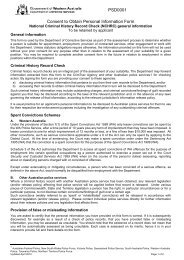
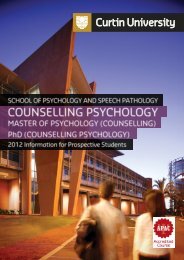
![Mental health commission report July 2010 - June 2011 [.pdf]](https://img.yumpu.com/50755705/1/184x260/mental-health-commission-report-july-2010-june-2011-pdf.jpg?quality=85)
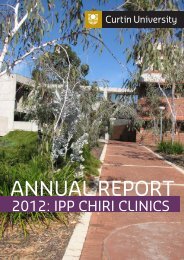
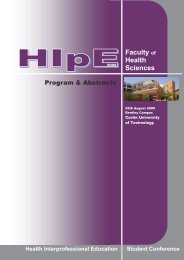

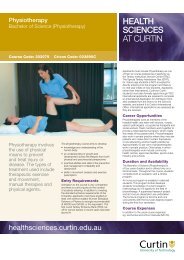
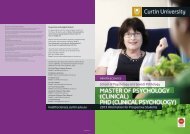
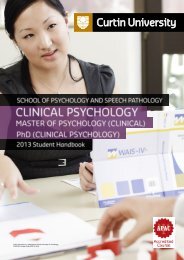

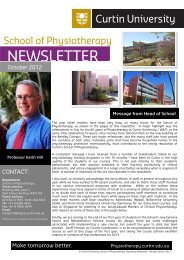
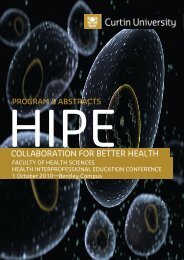

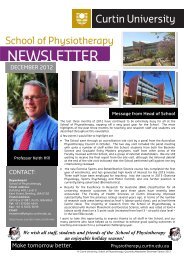
![2007 Annual Report [.pdf] - Health Sciences - Curtin University](https://img.yumpu.com/44476724/1/184x260/2007-annual-report-pdf-health-sciences-curtin-university.jpg?quality=85)